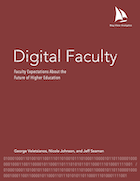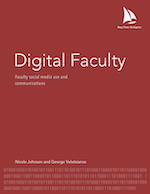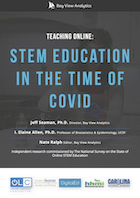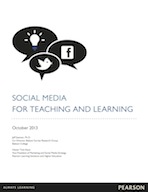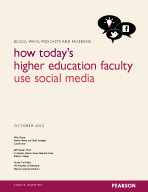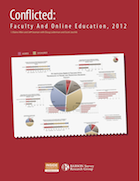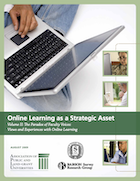Faculty Surveys
Digital Faculty: Faculty Expectations about the Future of Higher Education
Faculty teaching during a pandemic are evenly split between feeling optimistic or pessimistic about the short-term future of higher education. However, more faculty are optimistic than are pessimistic about the longer-term future. The study, Digital Faculty: Faculty Expectations about the Future of Higher Education, was conducted by Bay View Analytics in partnership with Online Learning Consortium and Pearson. Based on a representative sample of 1,131 faculty from across the United States, the survey addressed the opinions and expectations of faculty members about the future state of teaching and learning.
Most faculty are either optimistic or neutral about the future state of higher education. However, while they hope for better futures, they also have many concerns about their courses, students, and the state of the overall higher education system.
Findings include:
- Faculty are more optimistic and less pessimistic about higher education in the medium-term (5 years) than in the short-term (2 years).
- Nearly 9 out of 10 faculty view the COVID-19 pandemic as having a major impact on the future of higher education.
- About 8 out of 10 faculty report that they expect the impact of the COVID-19 pandemic on their institution will be long-lasting.
- Faculty also anticipate that online learning, income inequality, and political instability will have a continuing impact on higher education.
- About 60% of faculty expect that teaching and learning would be significantly different by 2025, and most anticipate the ongoing presence of online learning and financial constraints.
Digital Faculty: Faculty social media use and communications
Download: Digital Faculty infographic
The Digital Faculty project is a partnership between Pearson, the Online Learning Consortium, and Bay View Analytics. In the spring of 2020, 83% of the faculty surveyed said they moved a face-to-face course to emergency remote teaching. By fall of 2020 68% of those were still teaching one or more courses entirely online, with 30% more employing some form of blended methodology; 64% say their current teaching is different or very different in comparison to their teaching pre-pandemic.
This report addresses faculty use of social media and other methods for their personal and professional needs. The research found that most faculty use multiple social media platforms to varying degrees, though the nature of their use varies by platform. Faculty use some of their social media platforms daily or every few days (e.g., Facebook and Instagram) and use others (particularly research-focused platforms like Academia.edu and ResearchGate) far less frequently.
Findings include:
- Faculty are most likely to have social media accounts on Facebook (75%) and LinkedIn (65%).
- Faculty use social media professionally and personally; however, such use varies by platform (e.g., LinkedIn is used mainly for professional purposes, whereas Facebook is primarily used for personal purposes).
- The frequency of social media use varies by platform (e.g., Facebook is used daily or every few days by 74% of faculty, whereas LinkedIn is used every few weeks, monthly, or rarely by 71% of faculty).
- Faculty social media use is mostly passive. On all platforms, the majority of faculty reported posting content seldomly or never.
- Around 25% of faculty have a personal website (such as a blog or portfolio site). This faculty sub-group has several unique characteristics related to how they use social media, including an increased likelihood of Twitter use and being more likely to use Facebook, Instagram, Reddit, and Twitter for a mix of professional and personal uses.
- Faculty have mixed feelings about social media, holding both positive and negative opinions about both tools and their impacts across personal and professional dimensions.
- Compared to earlier studies, there has been very little change concerning faculty use of social media to communicate with students.
Teaching Online: STEM Education in the Time of COVID
The Online Learning Consortium (OLC) and Bay View Analytics, in partnership with Every Learner Everywhere, Carolina Distance Learning, DigitalEd, and with support from HHMI BioInteractive has released a new report exploring the impact of the COVID-19 pandemic on STEM faculty in higher education who underwent a hurried transition to online instruction.
Some highlights from the study include:
- 73% of respondents surveyed report having converted face-to-face coursework to remote learning, despite more than a third of respondents having no prior experience with online education.
- STEM faculty believe that almost all barriers they face in teaching their courses online are the same as those faculty in non-STEM discipline face. The need for online labs is the only barrier a majority of STEM faculty thought was unique for them.
- While generally optimistic about the potential effectiveness of online labs, only 18% of survey respondents have made use of them in their coursework.
- Respondents believe that the transition to online-learning has exacerbated the divide between the have and the have-nots, as a lack of resources (including but not limited to access to technology, robust internet connectivity, and support services) unfairly impacts underserved student populations.
Previous Faculty Reports
Social Media for Teaching and Learning 2013
A report from the Babson Survey Research Group and Pearson finds that college faculty members have become sophisticated consumers of social media, matching different sites to their varying personal, professional, and teaching needs, though obstacles to wider adoption still remain. The annual survey of nearly 8,000 teaching faculty encompassed all disciplines in higher education, with respondents selected to be representative of the overall range of faculty teaching in U.S. higher education. It examined both the personal and professional impacts of social media.
The report is available in multiple formats:
- PDF: Social Media for Teaching and Learning 2013
- E-book in epub format (Sony Reader, Nook, or iPad)
- E-book in mobi format (Kindle and Kindle DX)
- Infographic: Social Media for Teaching and Learning 2013
Key findings of the survey include:
- The level of personal use of social media among faculty (70.3 percent) mirrors that of the general population
- 55% of faculty use social media in a professional context (any aspect of their profession outside of teaching), up from 44.7% the previous year
- Only 41% of faculty use social media in the classroom, but this use continues to experience steady year-to-year growth
- Faculty are sophisticated consumers of social media, matching different sites to their varying personal, professional, and teaching needs
- Concerns remain about privacy, maintaining the class as a private space for free and open discussion, and the integrity of student submissions
- Most faculty agree that “the interactive nature of online and mobile technologies create better learning environments” and that digital communication has increased communication with students
- Faculty believe that online and mobile technologies can be distracting, and have resulted in longer working hours and more stress
"Faculty are not only expanding their use of social media, but also becoming more sophisticated in their use," said Jeff Seaman, Ph.D., co-director of the Babson Survey Research Group. "We see steady growth in adoption year over year; however, there are still great concerns that we hear from every age group, and that holds educators back from full adoption in their teaching."
Blogs, Wikis, Podcasts and Facebook: How Today’s Higher Education Faculty Use Social Media, 2012
College faculty have evolved their use of social media for professional, personal and instructional use, with a decrease in concerns around the value and amount of time spent using social media, according to a new report from the Babson Survey Research Group and Pearson. The annual survey of nearly 4,000 teaching faculty from all disciplines in higher education, representing U.S. higher education professors, examined both the personal and professional impacts of social media.
Key findings of the survey include:
- 64.4% of faculty use social media for their personal lives, 33.8% use it for teaching
- 41% of faculty under the age of 35 use social media in their teaching, compared to 30% of those over the age of 55
- Faculty in the Humanities and Arts, Professions and Applied Sciences, and the Social Sciences use social media at higher rates than those in Natural Sciences, Mathematics and Computer Science
- Blogs and wikis are preferred for teaching, while Facebook or LinkedIn are used more for social and professional connections
- 88 percent of faculty, regardless of discipline, reported using online video in the classroom
"Faculty are clearly becoming more comfortable leveraging social media in their personal, professional and instructional lives," said Jeff Seaman, Ph.D., co-director of the Babson Survey Research Group. "Social media is no longer seen as time-consuming to learn and use, which shows that faculty are more proficient and better acquainted with the social media tools available to them."
Digital Faculty, Professors, Teaching and Technology, 2012
Digital Faculty, Professors, Teaching and Technology, 2012 is a joint project by Inside Higher Ed and the Babson Survey Research Group.The same digital revolution that is changing day-to-day life for the general population also presents new options to faculty for their research and teaching. The growth of e-textbook options is one example: over one-third of faculty regularly assign books that are available in both e-textbook and traditional formats. Another area of rapid faculty adoption is in the use of video and simulations in courses.
Faculty members are selecting digital material from other sources, and creating their own for use within their classes. Forty-three percent of instructors say they create digital teaching materials, open educational resources, or capture lectures on a regular or occasional basis, but they do have concerns that the time and effort they put into the creation and production of their own materials will not be respected and rewarded by their institution.
Faculty are not yet abandoning traditional scholarly publishing outlets to embrace digital-only publications. The lack of faculty digital publication submissions does not mean that they do not respect online-only publications. When asked if the quality of online-only journals can be equal to work published in print, a majority of faculty members agreed that it could.
Faculty do not believe that online-only work is currently given the same level of respect in tenure and promotion decisions, but many faculty members believe that it should be.
Conflicted: Faculty and Online Education, 2012
Conflicted: Faculty and Online Education, 2012 is a joint project by Inside Higher Ed and the Babson Survey Research Group. It is designed to inject the voice of the faculty into the growing national discussion about online education. The study was made possible in part with the financial support of CourseSmart, Deltak, Pearson and Sonic Foundry. All decisions about the nature and wording of the surveys were made by the Babson Survey Research Group and Inside Higher Ed.The study is based on the results of two related, but separate, surveys. The first is a nationally representative sample of higher education faculty members who are teaching at least one course during the current academic year. The second focused on academic administrators – in particular those responsible for academic technology at their institutions.
Faculty report being more pessimistic than optimistic about online learning. Academic technology administrators, on the other hand, are extremely optimistic about the growth of online learning, with over 80% reporting that they view it with "more excitement than fear."
Professors, over all, cast a skeptical eye on the learning outcomes for online education. Nearly two-thirds say they believe that the learning outcomes for an online course are inferior or somewhat inferior to those for a comparable face-to-face course. Most of the remaining faculty members report that the two have comparable outcomes. Even among those with a strong vested interest in online education — faculty members who are currently teaching online courses – considerable concern remains about the quality of the learning outcomes.
Teaching, Learning, and Sharing: How Today's Higher Education Faculty Use Social Media
College faculty are twice as likely as other workers to be using social media as part of their job, and more than 80% of faculty are using some form of social media in their teaching, according to Teaching, Learning, and Sharing: How Today's Higher Education Faculty Use Social Media (PDF). The survey of nearly 2,000 faculty found that more than 90% of college faculty use social media in the workplace, compared to 47% of employees in other industries. In the classroom, 80% of respondents report using social media for some aspect of their course. Of those, nearly two-thirds use social media within their class session, and 30% post content for students to view outside of class.Use of social media is not without its problems; most faculty are concerned with the time it requires. The two most pressing concerns about faculty use of social media are privacy and integrity: 80% report that “lack of integrity of student submissions” is an “important” or “very important” barrier, and over 70% say privacy concerns are an “important” or “very important” barrier.
The Paradox of Faculty Voices: Views and Experiences with Online Learning
More than one-third of public university faculty have taught an online course while more than one-half have recommended an online course to students, according to Online Learning as a Strategic Asset, Volume II: The Paradox of Faculty Voices: Views and Experiences with Online Learning (pdf), an unprecedented study of administrative and faculty views toward online learning by the Association of Public and Land-grant Universities-Sloan National Commission on Online Learning.
Faculty with online development or teaching experience are not restricted to a particular class of faculty (such as part-time, non-tenure track, or those just beginning their teaching careers), but are well represented among all types of faculty. While there are some differences in participa- tion rates, the overall conclusion is that full- and part-time faculty, those at every stage of their career, and those on the tenure track, as well as those outside of the tenure track, are all involved in online instruction.
Recent Publications
Open Educational Resources
- Approaching a New Normal? Educational Resources in U.S. Higher Education, 2024
- Conflicted Digital Adoption: Educational Resources in U.S. K-12 Education, 2024
- Research Brief: Digital and OER Textbook Adoption
- Research Brief: Faculty Satisfaction with Course Materials varies by Publisher
Course Material Affordability
Digital Learning Pulse Surveys
- Infographic: 2023-2024 Digital Learning Pulse Survey
- The Digital Transformation of the Community College
- Planning for a Smaller Future: Dealing with Declining Enrollments
STEM
- Teaching Online: STEM Education in the Time of COVID
- What Makes a STEM Student
- Perceptions of the Future of STEM Education
Distance Education
- Digital Faculty: Faculty Social Media Use and Communications
- Infographic: Digital Faculty
- Grade Increase: Tracking Distance Education in the United States
Follow us on
Privacy
All survey respondents are provided complete anonymity. No personally identifiable information is released. Full privacy policy.
